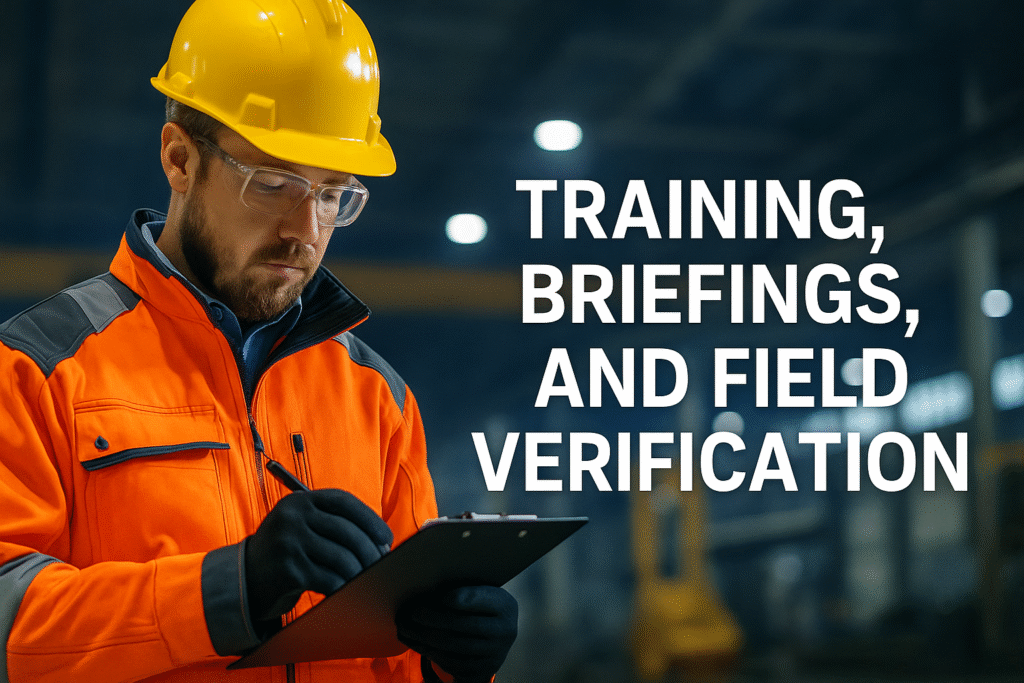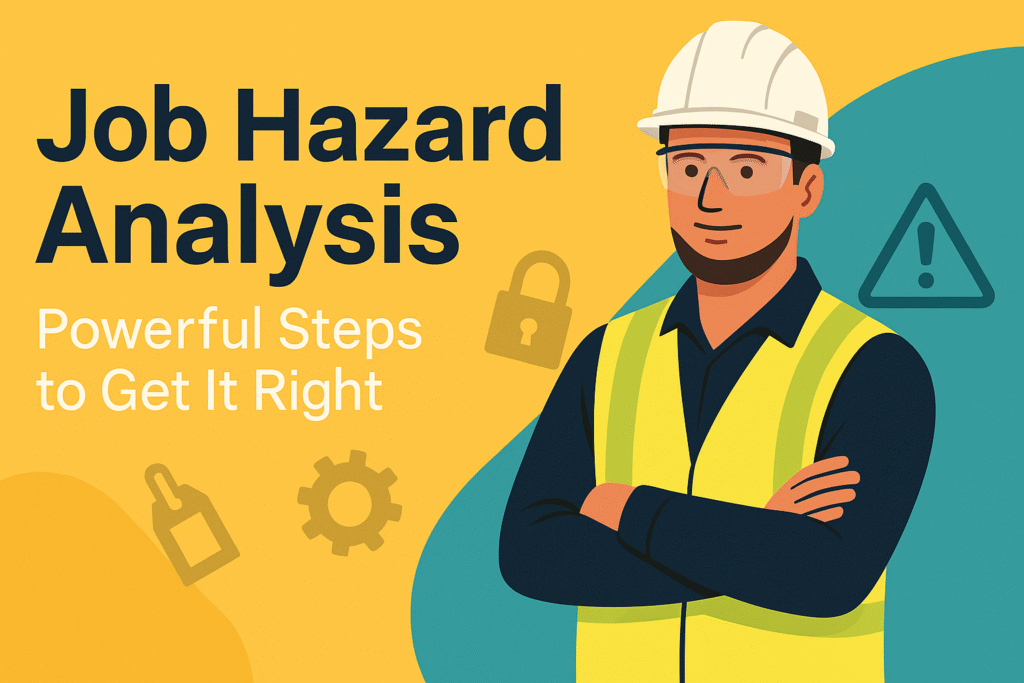Job Hazard Analysis is one of the simplest ways to turn unpredictable work into a reliable, repeatable process. At its core, Job Hazard Analysis breaks a task into steps, identifies the hazards in each step, and assigns the strongest feasible controls.

When it is written in plain language, validated on the floor, and used to kick off every job, Job Hazard Analysis becomes a living instruction—not a dusty form that only appears during audits.
- What Job Hazard Analysis is—and why it matters
- Choosing the right tasks for Job Hazard Analysis
- Step-by-step: how to perform a Job Hazard Analysis
- Applying the hierarchy of controls in Job Hazard Analysis
- Validating and documenting a Job Hazard Analysis
- Training, briefings, and field verification
- Common mistakes that weaken Job Hazard Analysis (and how to fix them)
- Ownership, review cycles, and continuous improvement
- A short real-world example
- Final thoughts
What Job Hazard Analysis is—and why it matters
Job Hazard Analysis (often called JHA or Job Safety Analysis) is a structured method to anticipate what can go wrong before work begins. Instead of relying on memory or generic rules, workers use the JHA to review concrete job steps, known hazards, and matching controls.
A good Job Hazard Analysis improves toolbox talks, clarifies permit needs, and accelerates onboarding because it captures how the job is actually performed in your workplace, not how a distant policy imagines it.
From a management perspective, Job Hazard Analysis also creates a feedback loop. Supervisors can observe work against the documented steps, verify controls, and record improvements.
Over time, that loop reduces variability, closes training gaps, and makes audits easier because you can show a consistent, risk-based method for routine and non-routine tasks.
Choosing the right tasks for Job Hazard Analysis
Not every task needs the same depth, but high-risk and high-frequency jobs should be prioritized for Job Hazard Analysis. Start with activities involving hazardous energy, line breaking, confined spaces, heavy mobile equipment, or frequent musculoskeletal strain.
Review incident and near-miss records, OEM manuals, and SDSs, then invite a small cross-functional team to a short scoping session. Include the working supervisor and one or two respected operators—tacit knowledge from skilled workers is the most reliable data your Job Hazard Analysis will ever contain.
When scoping the job, define clear boundaries. Where does the job start and end? What tools, spare parts, permits, and isolations are required?
What does “ready for service” look like? A precise scope keeps the Job Hazard Analysis focused and prevents scope creep that confuses users in the field.
Step-by-step: how to perform a Job Hazard Analysis
Begin by walking the job path at the actual worksite and breaking the task into five to ten steps. Each step should describe what is done, not how to be safe—for example: isolate equipment; verify zero energy; remove guard; replace belt; reinstall guard; test and return to service.
Clean, action-oriented steps make the Job Hazard Analysis readable and faster to brief.
For every step, identify hazards using multiple lenses: hazardous energy (electrical, mechanical, pneumatic, hydraulic), line-of-fire and pinch points, slips and falls, vehicle or pedestrian interactions, chemicals and respiratory exposures, thermal stress, ergonomics, biological hazards, and noise.
Ask, “What if conditions change? What if a control fails?” Physically tracing the worker’s movement will surface blind corners, awkward reaches, and unstable footing that paperwork alone never reveals.
Once hazards are listed, evaluate risk both before and after controls using a simple likelihood-by-severity matrix with definitions everyone understands.
Record a short rationale next to the score; this practice turns mysterious numbers into coaching tools and makes the Job Hazard Analysis easier to defend during audits.
Applying the hierarchy of controls in Job Hazard Analysis
Controls should follow the hierarchy: elimination, substitution, engineering, administrative, and PPE. Eliminate or substitute first whenever feasible—pre-assembling components off-line might remove a line-breaking step altogether.
Engineering controls (fixed guards, interlocks, barriers, lift tables, local exhaust) usually deliver the most reliable risk reduction. Administrative controls—permits, standard work, spotters, rotation—are useful but depend on human performance. PPE is essential, yet it is your last line of defense and should be specified precisely (e.g., cut-resistant gloves Level A4, CSA-approved eyewear, hearing protection with a target NRR).
If you’d like concise, authoritative refreshers while drafting, bookmark the NIOSH hierarchy of controls and OSHA’s excellent Job Hazard Analysis guide. For Canadian-oriented context and plain-language examples, see the CCOHS overview of Job Safety Analysis and practical articles at OHSE.ca.
Validating and documenting a Job Hazard Analysis
A draft is only the halfway point. Take the Job Hazard Analysis back to the job location and walk it with the actual crew.
Ask what’s missing, what’s hard to do in rain or low light, and what should trigger a “stop work and re-assess” call. Validation catches realities like tool availability, access constraints, and shift-change timing, and it builds buy-in so the JHA is a shared standard rather than a management artifact.
Document clearly in one page (front and back if needed) with consistent sections: task scope, steps, hazards, controls, required permits, PPE, verification checks, “STOP work if…” triggers, and sign-offs.
Use plain language and avoid jargon. If your site relies on mobile devices, add a QR code that links to OEM manuals and SDSs.
To embed the JHA in your operating rhythm, align it with your pre-task brief and safety policy—see our internal guides on how to write a compliant workplace safety policy and complementary methods like behavior-based safety so messages stay consistent.
Training, briefings, and field verification
Make the Job Hazard Analysis the anchor of your toolbox talk. Demonstrate critical controls rather than merely reading them—lock placement, try-start and meter test, interlock checks, correct lift-assist usage. Ask workers to echo back the top three hazards and controls for recall under pressure.

Post the JHA at the point of use: the permit station, the machine, or the job cart. Supervisors should then observe work with the JHA in hand, verifying that steps are followed in sequence, controls are present and functional, and verification checks are completed.
Quick notes from these observations feed minor updates and keep the document alive.
Common mistakes that weaken Job Hazard Analysis (and how to fix them)
A frequent mistake is jumping straight to PPE and skipping stronger options higher in the hierarchy. Another is treating the Job Hazard Analysis as a compliance artifact that is only pulled out during inspections.
A third is copy-pasting a JHA between sites without local validation. The fixes are straightforward: force the hierarchy into your template so elimination, substitution, and engineering are considered first; make the JHA your pre-task briefing sheet so it is used daily; and always conduct a short field walk with local operators before approving a new or transferred Job Hazard Analysis.
Ownership, review cycles, and continuous improvement
Every Job Hazard Analysis needs a named owner. Assign the working supervisor to maintain the document and a safety practitioner to coach on risk scoring and control strength.
Review cadence should reflect risk—quarterly for high-risk jobs, annually for moderate ones—and any material change in equipment, materials, layout, or season should trigger an immediate re-validation.
If your organization uses a management system such as ISO 45001, map JHA reviews to internal audits to keep improvements on schedule and visible to leadership.
Complement your JHAs with engineering safeguards where applicable—our overview of emergency stop systems in automated environments shows how critical controls and procedures reinforce each other.
A short real-world example
Consider a belt replacement on a guarded conveyor. The Job Hazard Analysis would include isolation and verification of zero energy, controlled removal of the guard with a temporary support bracket, manufacturer-approved tension relief, and a defined exclusion zone for line-of-fire hazards.
It would specify cut-resistant gloves and face protection for tension release, and it would require an interlock check and bump test with guards installed before returning to service.
This level of specificity converts paper controls into predictable, repeatable actions workers can execute without confusion.
Final thoughts
When you write a Job Hazard Analysis with clear steps, credible risk ratings, and layered controls that are validated on the floor, you create a durable safety habit. Workers know what to expect, supervisors know what to verify, and leaders can see risk shrink over time.

Start with one high-risk task this week, publish a clean JHA at the point of use, and use it to open every pre-task briefing.
That simple discipline compounds into fewer incidents, faster startups, and stronger compliance—all powered by a well-used Job Hazard Analysis.

No comments yet